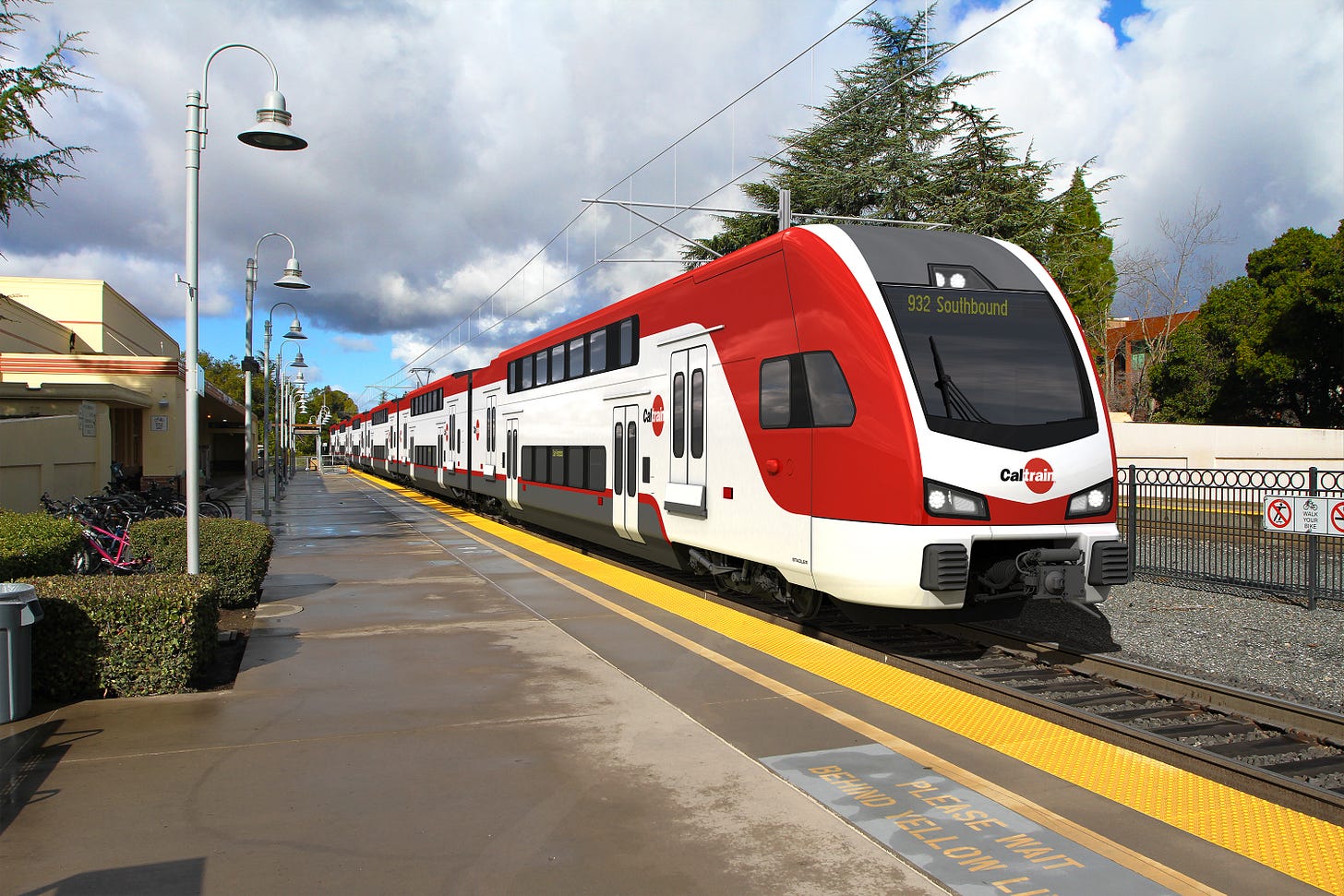Caltrain Orders Battery-EMU Trainset for Service to Gilroy
San Francisco - San Jose Electrification Startup Scheduled for 2024

Caltrain, the regional rail line running between San Francisco, San Jose, and Gilroy, took a beating from the COVID pandemic. Although they are starting to trend upward, passenger counts in June 2023 were just 39 percent of pre-pandemic levels. This is in large part because many employees now work from home or on a hybrid schedule that brings them to the office just a few days a week.
The carrier is not retreating, however. It is investing heavily to improve the line. A $2.4 billion electrification project is nearing completion. Seven-car EMU trainsets built by Stadler should be running between San Francisco and San Jose’s Tamien station by late next year.
Beyond San Jose diesel locomotives will still haul the railroad’s trains. However, last week Caltrain announced a novel solution that could see diesel locomotives go the way of steam.
The California Transportation Commission awarded the commuter line funds to acquire a four-unit battery-powered electric multiple unit (BEMU) trainset from Stadler. It will be the first double deck BEMU train in the United States. It is an add-on to Caltrain’s order with Stadler for 19 seven-car KISS EMU trainsets that the manufacturer is currently fulfilling.
Caltrain and Stadler officials expect the BEMU train to provide lower emissions, faster travel times, and lower operating costs than diesel locomotives. The train would lead to better service for riders and cleaner air between San Francisco and Gilroy.
In addition to the train, the $80 million grant covers testing at the Transportation Test Center in Pueblo, CO, and enhancements to the San Jose Central Maintenance Facility and Gilroy station.
The train will consist of three coaches and one car housing the battery and power equipment. While running under Caltrain’s 25,000 volt, 60 cycle catenary the battery will be charged. It will then power the train over the non-electrified section between Tamien station and Gilroy.
Caltrain and Stadler officials expect the BEMU train to provide lower emissions, faster travel times, and lower operating costs than diesel locomotives. The train would lead to better service for riders and cleaner air between San Francisco and Gilroy, said California Secretary of Transportation Toks Omishakin.
The carrier plans to “learn from the implementation to provide a roadmap for future BEMU operations and procurement,” it said in a statement. In addition to running between San Fransisco and Gilroy it will be used on demonstrations between Gilroy and Salinas and, possibly, other intercity and regional lines.
Ultimately it could enable Caltrain to operate a zero-emissions service in the future as BEMU trains replace aging diesel locomotives. This experiment bears watching. There are several lines, particularly in the New York region, that are electrified through the close-in suburbs but dieselized in more distant areas. Examples include the Long Island Rail Road to Montauk, Metro North to Poughkeepsie, and NJ Transit to Bay Head Junction.
Stadler is working with Utah State University and the ASPIRE Engineering Research Center to develop a single-level, two car BEMU train. This could be used to extend services that now end where the catenary stops, such as from Morrisville to Reading, PA.
Two earlier proposals for battery powered trains did not pan out. In 2021 the Long Island wanted to modify EMU cars for battery-powered service on its Oyster Bay Branch but cancelled the project after determining the retrofit was not feasible. The same year Chicago’s METRA wanted to convert some F40PH-3 locomotives to battery operation but could not reach terms on a contract with Progress Rail.
Caltrain’s market has undergone a tectonic shift as workers abandoned downtown offices for working from home. Higher speeds and cleaner operation promised by electrification could bring some of them back. But the carrier has to get people to ride throughout the day not just during peak periods.
One hurdle that will be tough to clear is the problem of getting passengers from the terminal at Fourth Street and King Avenue to downtown San Francisco. Now they have a 17-minute ride on the F streetcar line. That is about as long as it took me to get from Pennsylvania Station at 32nd Street to 145th Street and St. Nicholas Avenue when I worked at City College.
Caltrain wants to run to the new Salesforce Transit Center, which has space for a train station on the lower level. But the build has a $3.9 billion – and climbing - price tag and no money has been allocated. Since the California High-Speed Rail Line would also use the station, as well as Caltrain’s route north of San Jose, it would be easier to justify the cost.
Passenger trains have been running between San Francisco and San Jose since 1864. For most of those years the Southern Pacific Railroad provided the service and it was the only commuter line west of Chicago. Caltrain faces an uncertain future with its head held high.



